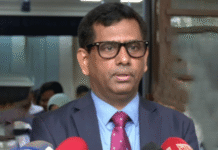Government denies approving industries around Sundarbans
 The Bangladesh government has denied that it issued approval for any heavy industry close to the Sundarbans, country’s only, and the world’s largest, mangrove forest. However, the records show thatr so far 320 new industrial projects have been approved by the government around the forest.
The Bangladesh government has denied that it issued approval for any heavy industry close to the Sundarbans, country’s only, and the world’s largest, mangrove forest. However, the records show thatr so far 320 new industrial projects have been approved by the government around the forest.
The government issued a letter to the United Nations Educational, Scientific and Cultural Organization(UNESCO) denying their approval of the industries and also saying that they conducted an Environmental Impact Assessment (EIA) accurately before implementing the Rampal power plant project.
Sundarbans’ biodiversity is widely important for the world’s ecosystem. The Bangladesh government submitted a progress report to the World Heritage Committee on 3 December last year as to maintain the status of Sundarbans as world heritage. The report said that the government has taken some additional initiatives to protect the Sundarbans as well as to meet UNESCO’s conditions.
However, the World Heritage Committee of UNESCO will make the decision in July this year, whether or not the status as the Sundarbans will retain its world heritage status as its natural resources are at stake.
However, the National Committee to Protect Sundarbans sent a letter to the UNESCO citing the government has approved 320 factories within 10 kilometre surrounding the forest despite UNESCO’s time and again objections.
The letter also said, among the projects, 24 are highly prone to release deadly environmental pollutants which will push the Sundarbans gradually towards destruction.
Apart from this, UNESCO was told that the EIA of Rampal power plant was not done accurately, it would have to be done afresh. But the government has not conducted any EIA anew.
Deputy minister of environment, forest and climate change Habibun Nahar said, “The people of Rampal and Mongla used to starve. Only industrialisation can eradicate poverty in the area and this will not be possible without electricity.”
“That is why we proposed the Rampal power plant. We are doing it with proper measures to protect the environment,” she claimed.
In the meeting of World Heritage Committee held in Krakow, Poland in July 2017, Bangladesh was given several conditions to protect Sundarbans. There were eight conditions, including stopping the operation of the Rampal power plant and not allowing industrialisation around the Sundarbans.
It is said an evaluation report will be discussed in the 2019 meeting on what Bangladesh did to fulfil these conditions so far.
Earlier, in December 2018, UNESCO asked Bangladesh government to submit a report in this regard.
Following that the government said in report in December last year, the task of assigning an organisation to carry out a strategic environmental assessment (SEA) on the south-western region of the country including the Sundarbans has been finalised. Also, the government is said to have taken initiatives to avoid any kind of pollution at Rampal coal-based power plants project.
The report also stated that a special action plan including the Tiger Recovery Programme was taken up with special supervision to protect the Royal Bengal Tigers in Sundarbans. It was mentioned that the filling of Gorai river is one of the main obstacles to fresh water flow through the Ganges from India. Initiative has been taken to dredge the river. Also, EIA was carried out before the river dredging.
However, the National Committee to Protect Sundarbans convenor Sultana Kamal said, “Whatever the government’s official statements say, we have seen that the EIA of Rampal power plant was faulty. It has to be done afresh.”
“The Sundarbans cannot be preserved unless the projects the construction of industries there is halted for once and for all,” she added.
*This report originally published in Prothom Alo print edition has been rewritten in English by Farjana Liakat









